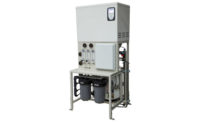Air handlers, like the rest of the HVAC industry, continue to evolve thanks to new technology enhancements. By incorporating increased motor efficiency, design improvements and the utilization of energy recovery options, manufacturers are producing units that are more efficient, intelligent and connected than ever before.
In fact, the global air handling unit market, which was estimated at $6.93 billion in 2016, is projected to reach $12.91 billion by 2026, growing at a compound annual growth rate (CAGR) of 5.7 percent from 2016 to 2021, according to a report from MarketsandMarkets. The rising usage of air handling units across various application sectors such as commercial buildings, hospitals, industries, universities, data centers and server rooms is expected to fuel the growth of the air handling units market, the report notes.
Increasing Customization
The current trend is moving away from standard cookie-cutter rooftop units, according to Tom Morgan, sales, technical support and training, at John J. Morgan Co., a Reznor representative in St. Paul, Minnesota. Reznor is a brand of Nortek Global HVAC LLC.
“Sure, there is still a market for it, but there is an increasing call for custom units, or standard units with custom accessories including but not limited to: special filters, higher outside air capabilities, high tech and DDC type controls, energy recovery, and all of this at a competitive price,” Morgan said. “As low tech as HVAC is perceived to be, it actually is as high tech and evolving as just about any industry. Controls have become cutting edge, and efficiencies [and efficiency requirements] are ever increasing. But again, all of this is demanded at low competitive prices. There is so much competition with so many manufacturers. All of the big-name manufacturers have several brands and iterations of their core products simply flooding the market and driving prices down. Pricing pressure continues to trend down in an already overheated competitive market.”
Morgan said with pricing pressures spiraling downward, wholesalers should be concerned. “As competition increases, and code requirements and efficiency requirements increase, but pricing pressures continue downward, margins also decrease.”
According to Morgan, the Reznor R7TQ rooftop units give customers the flexibility to customize for their needs and costs.
“The key is availability,” he said. “If the product is stocked, and it is competitive, it will sell. If it is ‘not available until tomorrow’ for example, it is a lost sale. This will become even trickier as the need and desire for custom units and accessories continue to increase. What does one stock? What is the correct mix? How do we stay remotely competitive?”
Pushing Toward Higher Efficiency
Chris Day, director, product management, Air Conditioning Division, Rheem Mfg. Co., is seeing more trends in the market for units with higher efficient motors, dehumidification options, better connectivity, and easier installation and serviceability.
“In the next five years, air handlers will be taken to the next level when it comes to prognostics and diagnostics with the use of added components and temperature sensing,” Day said. “This will allow homeowners to have better control of their home energy costs, comfort and insight into the overall system health.”
Rheem’s EcoNet® Enabled High-Efficiency Modulating RHMV Air Handler is designed for maximum energy efficiency and quiet operation. The unit reduces monthly energy bills because it features a high-efficiency, constant cfm, variable-speed blower motor that modulates the airflow based on cooling demand for enhanced SEER and HSPF performance. Additionally, the air handler is equipped to operate with the EcoNet Smart Home System, which combines select Rheem Heating, Cooling and Water Heating solutions into one integrated network so the homeowner can effortlessly manage home comfort and energy usage from anywhere with the control center, free mobile app or mobile-friendly web portal. This innovative technology sends important alerts and reminders to keep the system working at its best. It also is designed with a versatile, four-way convertible design to allow the unit to fit in a variety of homes.
In addition to the trend toward higher efficiency, Rob Tanner, director, product marketing, Air Handling Systems, Johnson Controls Inc., sees increased use of direct drive versus belt drive to reduce drive losses; arrays of fans versus single fans; electronically commutated motor (ECM) fans; energy recovery, and more.
“There is also an increased trend of IEQ [indoor environmental quality], which consists of thermal conditions – the temperature and humidity level inside the space and the ability to control it; improving the quality of air in the building to improve human performance; and acoustics – not just quieter, but understanding and managing sound to improve human performance in buildings,” Tanner said. “Rising energy costs and an increasingly Earth-friendly perspective has resulted in standards, codes and incentives to reduce energy consumption. We are looking critically at every area of the HVAC system. Second only to the central plant, the air handler is the largest energy consumer in the HVAC system.
“Additionally, people represent the most valuable asset of most businesses,” he continued. “Creating building environments that maximize human performance optimize the value of that asset. Traditionally, the HVAC industry has focused on the thermal conditions inside the building. As a result of continued analysis and study, we now have evidence of the importance of the other factors of IEQ - particularly the IAQ and acoustical elements which are impacted by the air handler.”
Tanner adds there is an increasing trend of a reduced footprint in air handlers as well as factory integration of controls and electrical wiring to reduce the amount of time it takes to put a unit into operation once it arrives at the job site. Seismic-rated equipment also is on the rise in areas across the U.S.
“Over the last seven years or so, there has been a growing number of building codes that have adopted seismic requirements in their building construction, and it extends to all of the equipment that is attached to those buildings,” Tanner said. “And it’s for all equipment, not just unique to air handling. We’re having to comply with these codes in areas we never really thought of before as having seismic activity. We understood and expected it in areas where traditionally you would have seismic events and seismic fault lines, but more of the country is adopting these international building codes now.”
Ken Ely, product manager, Unitary Products Group, Johnson Controls Inc., sees tighter construction in air handlers to minimize losses and infiltration, helping contractors who do blower door testing or who participate in LEED programs.
“Real trends occur over time, so many of the needs have not changed, but improvements in electronics and motor technologies have provided the tools which the industry has used to not only address the needs, but make fundamental improvements in important attributes such as efficiency and capacity,” Ely said. “Wholesalers should view these trends positively, in that addressing these trends has the potential to consolidate and reduce SKUs while simplifying installation and diagnostics for the installing contractor.”
The YORK® Affinity™ Series AVV Air Handler features an advanced MaxAlloy™ coil, which is optimized for effective airflow and comes with a factory-mounted EEV. The variable-speed fan motor provides more consistent comfort and less power consumption.
“There will continue to be demands for increased airflow with the combined ability to deliver it against a higher static pressure over the next five years,” Ely said. “As homes and structures get tighter, the need for IAQ equipment is increasing, depending on the solution applied. Many times, it adds static to the duct system, adding to the demand for stronger blower systems. Added electronic functionality, including lifestyle auto configuration based on smart device input whole home automation integration, are a couple of the needs we will see being addressed with more eloquent integration in the very near future.”









